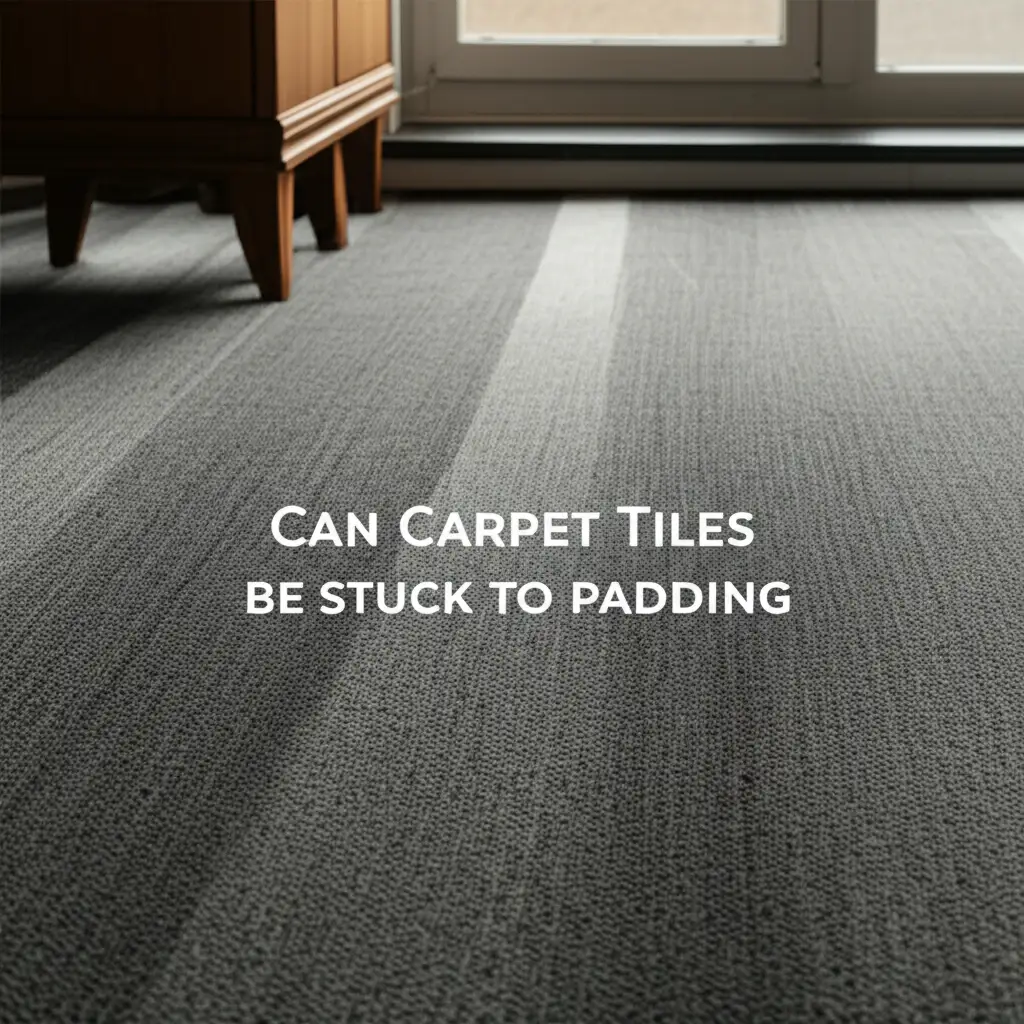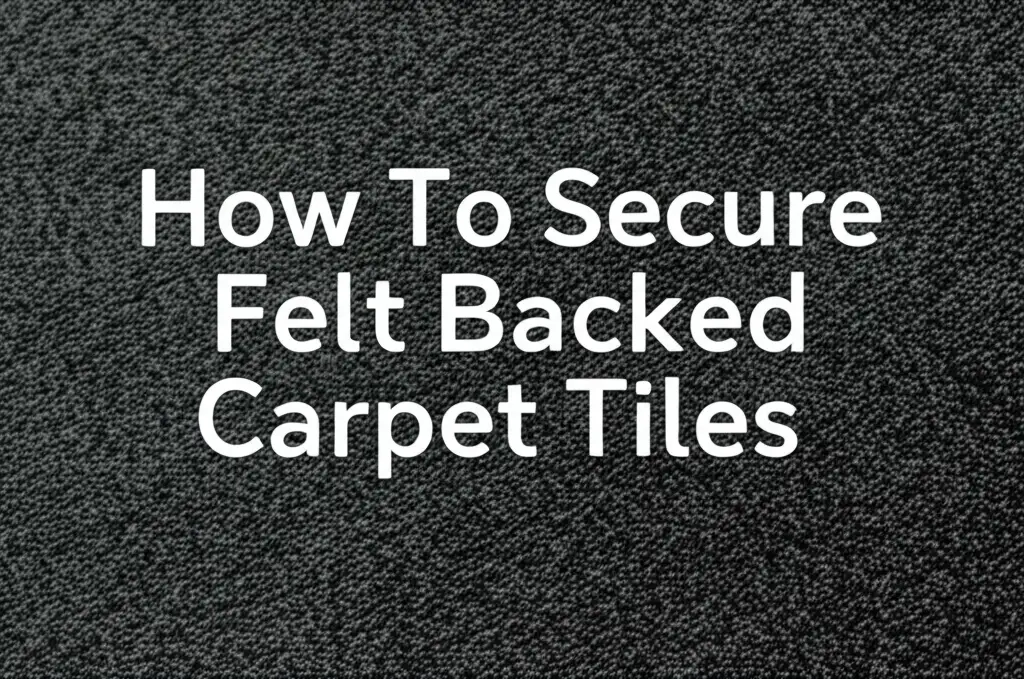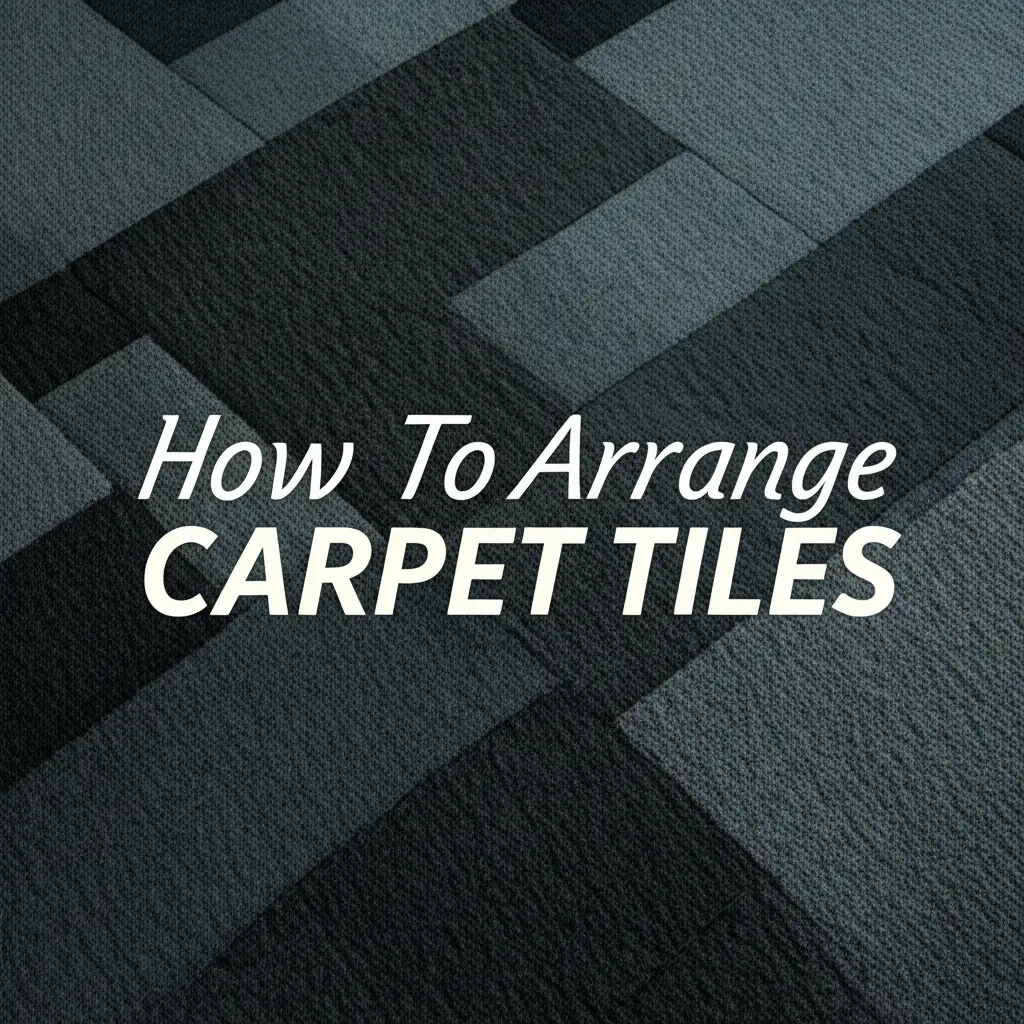· Liora Benning · Flooring Solutions · 12 min read
Can Carpet Tiles Be Stuck To Padding

Can Carpet Tiles Be Stuck to Padding for a Comfortable Floor?
Are you thinking about upgrading your floors? Carpet tiles offer a smart, versatile option for many spaces. They provide flexibility and make DIY projects possible. A common question people ask is, “Can carpet tiles be stuck to padding?” This idea often comes from wanting a soft feel underfoot, like traditional carpet.
Understanding the right way to install flooring is important for good results. My goal today is to explain if sticking carpet tiles to padding works. We will explore the pros, cons, and proper installation methods. This article helps you make informed choices for your home flooring.
Takeaway
- Avoid Direct Adhesion: Do not stick carpet tiles directly to carpet padding.
- Subfloor is Key: Always install carpet tiles directly onto a clean, smooth, and stable subfloor.
- Consider Integrated Padding: Choose carpet tiles with attached cushion for added comfort.
- Use Area Rugs: Place area rugs on top of installed tiles for localized softness.
- Prepare Thoroughly: Proper subfloor preparation ensures a lasting carpet tile installation.
A Clear Answer: Can Carpet Tiles Be Stuck To Padding?
No, you should not stick carpet tiles directly to carpet padding. Carpet tiles need a firm, stable surface for proper adhesion and long-term performance. Padding is soft and moves, which prevents adhesives from bonding correctly and causes the tiles to shift, buckle, or separate over time.
Understanding Carpet Tiles and Padding: What’s the Purpose?
Carpet tiles are modular carpet pieces. They offer great versatility for design and easy replacement. Many people use them in homes, offices, and commercial spaces. You can create unique patterns and easily swap out damaged sections.
Carpet padding, on the other hand, is a cushioned layer. Installers place it under broadloom carpet rolls. Padding adds comfort and provides insulation. It also helps with sound absorption and extends the life of traditional carpets. The padding cushions the carpet fibers from foot traffic.
The purpose of these two materials is different. Carpet tiles are designed for direct adhesion to a hard surface. Padding is made to compress and bounce back, providing a soft base for a full carpet roll. Trying to combine them in the wrong way causes problems.
People often ask about sticking carpet tiles to padding because they want the softness padding offers. They might assume all carpet installations use padding. However, carpet tiles have specific installation requirements for stability. Understanding these differences helps you make smart choices for your floor.
Why Direct Adhesion to Padding Fails: Key Challenges
Sticking carpet tiles directly to padding causes many problems. The main issue is the nature of the padding itself. Padding is soft and compressible. It moves when walked on. This movement creates an unstable base for carpet tiles.
Most carpet tile adhesives need a rigid surface to bond properly. The adhesive forms a strong connection with the subfloor. When applied to padding, the adhesive cannot get a firm grip. The padding absorbs the adhesive or allows it to flex. This leads to bond failure over time.
You will see problems quickly. Tiles might shift out of place. Gaps can appear between tiles. The edges might curl up. This not only looks bad but also creates tripping hazards. It also wears down the carpet tiles unevenly.
Another big concern is durability. An unstable installation shortens the life of your carpet tiles. The constant movement puts stress on the tile backings and fibers. This leads to premature wear and tear. Also, most carpet tile manufacturers require installation over a hard, stable subfloor. Failing to follow these guidelines can void your product warranty. This means if problems occur, the manufacturer might not cover the cost of repairs or replacement. Proper installation ensures your investment lasts.
The Direct Answer: Sticking Carpet Tiles to Padding – Is It Recommended?
Let’s be very clear: no, sticking carpet tiles to padding is generally not recommended. This method almost always leads to poor results. The core issue lies in the fundamental design of each product. Carpet tiles need a flat, hard, and stable surface to bond effectively. Padding provides a soft, compressible, and often uneven surface.
When you apply adhesive to padding, the bond becomes weak. The padding compresses with weight and foot traffic. This constant movement makes the adhesive lose its grip. Tiles will shift, creating unsightly gaps or dangerous curled edges. They may even separate completely from the padding. This method can also make your carpet tiles wear out faster. The instability puts stress on the tile’s backing and fibers. This leads to an unappealing, short-lived floor.
For example, when you secure felt-backed carpet tiles, you usually apply adhesive or use their self-adhesive backing directly to the subfloor. The purpose is to create a fixed, stable floor. Padding prevents this stability. Always ensure your subfloor is clean, dry, and flat before installation. This ensures your carpet tile flooring performs as it should for many years. Proper installation protects your investment.
How to secure felt-backed carpet tiles
Alternatives for Adding Comfort and Insulation with Carpet Tiles
Even though sticking carpet tiles to padding is not ideal, you can still achieve comfort. Several excellent alternatives exist. These options help you get the soft feel you want without compromising the carpet tile installation. Each method works with the inherent design of carpet tiles.
One popular choice is to use carpet tiles with integrated padding. Many manufacturers offer this product. These tiles come with a thin layer of cushion already attached to their backing. This built-in padding offers a softer step. It also provides some sound absorption. The adhesive is on the tile itself, designed to bond directly to the subfloor. This ensures a stable installation. You get the comfort without needing separate padding.
Another option involves installing standard carpet tiles directly on your subfloor. Then, you can add area rugs or rug pads in specific zones. This gives you concentrated softness where you need it most. For example, place a thick rug pad under a decorative area rug in your living room. The carpet tiles provide the base, and the area rug adds comfort and style. This method maintains the stability of the carpet tiles. It also allows for flexible design changes.
How to arrange carpet tiles can give you ideas for creative placement and design. You can also explore different ways to how to keep a carpet down for a stable and secure floor, including methods for tiles and area rugs. Choosing the right alternative ensures both comfort and a durable carpet tile floor.
Proper Installation of Carpet Tiles: Best Practices
Installing carpet tiles correctly ensures their longevity and appearance. The process begins with thorough subfloor preparation. A clean, dry, and level subfloor is essential. Any dirt, dust, or debris can prevent the adhesive from bonding. Moisture can cause mold or adhesive failure. High spots or dips will make tiles uneven and prone to buckling.
Before installation, let your carpet tiles acclimate. Bring the tiles into the room where you will install them. Let them sit for at least 24-48 hours. This allows the tiles to adjust to the room’s temperature and humidity. This step helps prevent expansion or contraction after installation.
Next, plan your layout. Determine the starting point, usually the center of the room. Snap chalk lines to guide your tile placement. This ensures a straight and even installation. A good layout minimizes waste and makes the final look professional.
When applying adhesive, choose the correct type for your tiles. Pressure-sensitive adhesive is common for carpet tiles. This adhesive remains tacky, allowing you to reposition tiles if needed. For permanent installations, you might use a stronger, permanent bond adhesive. Always follow the manufacturer’s instructions for adhesive application and drying times.
Lastly, pay attention to cutting and fitting tiles. Use a sharp utility knife and a straightedge. Cut tiles from the back for a cleaner edge. Press each tile firmly into the adhesive. This ensures full contact and a strong bond. Following these steps leads to a beautiful and durable carpet tile floor. For more on arrangement, see how to arrange carpet tiles. Also, understanding methods to how to secure felt-backed carpet tiles can provide further insights into proper adhesion.
When Padding Might Be Underneath (But Not Adhered To)
Sometimes, you might encounter a situation where padding is present in a room before installing carpet tiles. This usually happens if you are removing old broadloom carpet. Traditional carpet always uses padding underneath it. When you decide to switch to carpet tiles, you must remove both the old carpet and its padding completely.
The key distinction is critical: carpet tiles go directly onto the subfloor, not over existing padding. This means after you pull up the old carpet, you must also remove all the padding. Check the subfloor carefully. Look for any staples, nails, or adhesive residue. You must remove these. Any leftover material can create bumps or prevent proper adhesion for your new carpet tiles.
The subfloor must be clean, dry, and smooth. This step prepares the surface for the carpet tile adhesive. If the subfloor is concrete, ensure it is fully cured and free of moisture. For wood subfloors, check for loose boards or squeaks. Secure any loose areas. Repair any damage. This ensures a stable base for your carpet tiles.
Trying to install carpet tiles over existing padding, even old, flat padding, will cause problems. The padding still retains some compressibility. It will shift and buckle, causing the carpet tiles to fail. Therefore, the old padding must go. You can find more information about general carpet removal processes in guides like how to take the carpet out of tile floor. Also, if you’re concerned about floors without padding, understanding how to clean carpet that has no padding underneath it provides useful context about subfloor direct installations.
Benefits of Correct Carpet Tile Installation
Properly installing carpet tiles offers many advantages. When you follow manufacturer guidelines, your flooring investment pays off. The most immediate benefit is durability. Carpet tiles installed on a stable subfloor last a long time. They resist wear and tear from foot traffic effectively.
Another key advantage is easy replacement. If a tile gets stained or damaged, you simply replace that single tile. You do not need to replace the entire floor. This saves both time and money in the long run. It makes maintenance simple and straightforward.
Carpet tiles also offer immense design flexibility. You can create unique patterns, borders, or color blocks. This allows for personalized aesthetics in any room. Their modular nature makes design changes easy if you want a new look later. This versatility is a huge plus for creative homeowners.
Cost-effectiveness over time is another benefit. While the initial cost might be similar to broadloom, the ease of repair saves money. You avoid expensive full floor replacements. Additionally, many carpet tiles use low VOC (Volatile Organic Compound) adhesives. This contributes to improved indoor air quality. Choosing the right carpet tiles and installing them correctly ensures a beautiful, functional, and healthy floor for years to come.
FAQ Section
Q: Can I lay carpet tiles over old carpet with padding?
A: No, you cannot lay carpet tiles over old carpet or its padding. Carpet tiles need a flat, hard, and stable surface for proper adhesion. The old carpet and padding will cause instability, leading to the new tiles shifting, buckling, and failing to stick. Always remove all existing flooring down to the subfloor.
Q: What adhesive should I use for carpet tiles?
A: Most carpet tiles require a pressure-sensitive adhesive. This type of adhesive remains tacky, allowing for repositioning of tiles during installation. Some tiles have peel-and-stick backings. Always check the specific manufacturer’s recommendations for the best adhesive for your chosen carpet tiles.
Q: Do carpet tiles need a subfloor?
A: Yes, carpet tiles absolutely need a proper subfloor. They are designed to bond directly to a clean, dry, smooth, and level subfloor. This can be concrete, plywood, or other hard, stable surfaces. The subfloor provides the necessary rigidity for the adhesive to form a strong, lasting bond.
Q: How do I add comfort to carpet tiles if I can’t use padding?
A: You can add comfort by choosing carpet tiles with attached cushioning. These tiles have a thin layer of padding already integrated into their backing. Alternatively, install standard carpet tiles directly on the subfloor. Then, place area rugs with thick rug pads in specific zones where you desire extra softness.
Q: What are the best carpet tiles with built-in padding?
A: Several brands offer carpet tiles with attached cushion, often called “cushioned-back” or “comfort-back” tiles. Brands like Interface, Shaw, and Milliken provide options. Research different products to find styles and cushion levels that meet your comfort and design needs. These provide softness while maintaining stability.
Q: Can I use double-sided tape to attach carpet tiles to padding?
A: No, double-sided tape is not suitable for attaching carpet tiles to padding. Like adhesive, tape needs a stable, non-compressible surface to bond effectively. Tape applied to padding will lose its grip as the padding moves and compresses. This will cause the tiles to shift or lift.
Conclusion
So, can carpet tiles be stuck to padding? The answer is a clear no. While the idea of adding extra softness is appealing, attaching carpet tiles directly to padding creates an unstable floor. The compressibility and movement of padding prevent proper adhesion. This leads to shifting tiles, unsightly gaps, and reduced durability for your flooring.
I strongly recommend installing carpet tiles directly onto a clean, dry, and stable subfloor. This method ensures a strong bond and a long-lasting, beautiful floor. If you desire more comfort, consider carpet tiles that come with integrated padding. These tiles offer softness without compromising stability. You can also use area rugs over your installed tiles for added comfort in specific spots.
Plan your flooring project wisely. Prioritize proper installation techniques. Doing so will ensure your carpet tiles look great and perform well for many years. A little preparation goes a long way. Make a choice that lasts.





